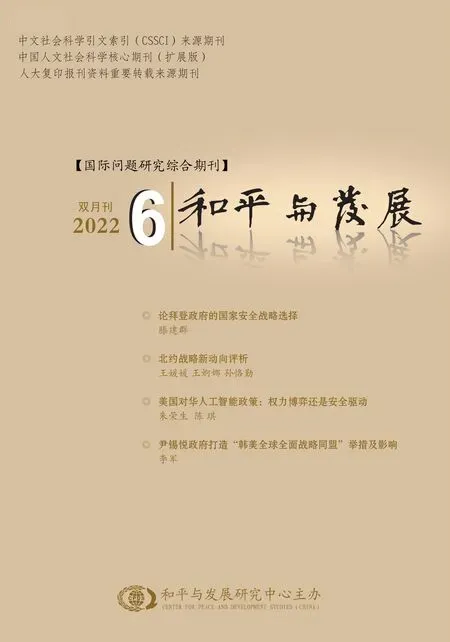The Logic of the United States to Reshape the Semiconductor Industry Chain
Under the combined influence of the comprehensive competition launched by the United States against China, the worldwide COVID-19 pandemic and the Ukraine crisis, the global semiconductor industry chain has suffered a major shock, resulting in prolonged logistics obstruction and “l(fā)ack of chips”, which has greatly aばected many industries around the world.In response, the United States, the European Union, Japan, South Korea and other major semiconductor manufacturing countries or regions have introduced strategic measures one after another to enhance technology research and development and supply chain resilience.
The US semiconductor industry is dominant in design, equipment and materials, but weak in manufacturing, especially in advanced manufacturing processes, and heavily relies on East Asia.For the United States, which pursues “absolute security”, once natural disasters, geopolitical and public health risks occur in East Asia, the entire semiconductor supply chain may be interrupted,posing a threat to the US economy and national security. In this context, reshaping the semiconductor industry chain has become an important issue after the Biden administration took oぴce, and the Chip and Science Act oぴcially launched in August 2022 has become an important symbol. Its goal is not only to make up for the weakness of US manufacturing capacity and solve the problem of chip shortage, but also to master and control cutting-edge chip technology and gain an upper-hand in the high-tech competition with China. To this end, the US government has adopted three major measures to reshape the semiconductor industry chain.
First, dynamically and precisely cracking down semiconductor production and supply chain to China. The Trump administration embarked on a strategy of “decoupling” the semiconductor industry from China, including a number of Chinese companies involved in semiconductors on an “entity list” of export control and banning US companies from investing in specific Chinese companies. After Biden administration took oぴce, it continued to escalate the scope and intensity of the crackdown, and adopted a dynamic and precise strategy, that is, the scope of sanctions is not limited to advanced technologies, but includes all those that mainland China has not mastered into the scope of sanctions, and dynamically adjust it according to the development of the technology. At the same time, the US is actively exploring the feasibility of semiconductor technology collaboration with other countries to promote consensus on the issue of “decoupling”from China.
Second, strengthening technology research and development and encouraging advanced semiconductor companies to build factories in the United States. In order to control the cuttingedge semiconductor technology, the United States has resumed its industrial policy. On the one hand, the US has strengthened the investment in science and technology as well as basic research and talent building, deeply participated in the research and development of emerging technologies, and reversed the downward trend of the federal government’s research and development funds over the years. On the other hand, by leveraging and enhancing market dependence, providing incentives, politicizing the issue and other means, the US is trying to promote TSMC and Samsung, the only companies in the world that are capable of producing chips below 10nm, to invest and build factories in the United States.
Third, building the semiconductor industry chain alliance. Under the pretext of enhancing the supply chain resilience, the US has built multi-tier industrial and technological alliances, such as US-Japan, US-South Korea, US-Europe alliances, chip “quadrilateral alliance”, the “QUAD mechanism”, and the “Indo-Pacific Economic Framework”. Through such eばorts, the US intends to promote the complementary advantages of semiconductor technology among various countries and further improve its R&D strength and advanced manufacturing capacity on the one hand. On the other hand, it tries to exclude China from the advanced semiconductor supply chain with the closed-loop of the industrial chain and lock up the development space of China’s semiconductor industry.
The Biden administration’s measures to reshape the semiconductor industry chain, especially the introduction of the Chip and Science Act, will strongly promote the plans of TSMC, Samsung,Intel and other companies to set up factories in the United States. It is expected that after the completion of these factories, the technique of US chip manufacturing will be rapidly improved and advanced chips needed for US critical infrastructure will be secured. At the same time, more enterprises will be attracted to increase investment in the United States. But America’s ambitions to shift away from East Asia and take the lead in semiconductor manufacturing technology still face significant diぴculties, given the high cost of producing advanced chips in the US, the lack of an advanced packaging ecosystem there, the shortage of highly skilled workers at home and the diぴculty of uniting allies to contain China.
(About the authors: Wu Zelin is an Associate Research Fellow at the Institute of International Studies, Shanghai Academy of Social Sciences; and Shang Xiucheng is a Graduate Student at the Institute of International Studies, Shanghai Academy of Social Sciences. This article was received on Oct. 12, 2022.)

